| Article ID | Journal | Published Year | Pages | File Type |
|---|---|---|---|---|
| 8751742 | Virus Research | 2018 | 37 Pages |
Abstract
Many viruses make use of, and even direct, the ubiquitin-proteasome system to facilitate the generation of a cellular environment favorable for virus replication, while host cells use selected protein ubiquitylation pathways for antiviral defense. Relatively little information has been acquired, however, regarding the extent to which protein ubiquitylation determines the replication success of picornaviruses. Here we report that the ubiquitin-protein ligase E6AP/UBE3A, recently shown to be a participant in encephalomyocarditis virus (EMCV) 3C protease concentration regulation, also facilitates the early stages of EMCV replication, probably by a mechanism that does not involve 3C protease ubiquitylation. Using stably transfected E6AP knockdown cells, we found that reduced E6AP concentration extends the time required for infected cells to undergo the morphological changes caused by virally induced pathogenesis and to begin the production of infectious virions. This lag in virion production is accompanied by a corresponding delay in the appearance of detectable levels of viral proteins and RNA. We also found, by using both immunofluorescence microscopy and cell fractionation, that E6AP is partially redistributed from the nucleus to the cytoplasm in EMCV-infected cells, thereby increasing its availability to participate in cytoplasmic virus replication processes.
Related Topics
Life Sciences
Immunology and Microbiology
Virology
Authors
Marybeth Carmody, Joshua T. Zimmer, Camille H. Cushman, Thao Nguyen, T. Glen Lawson,
